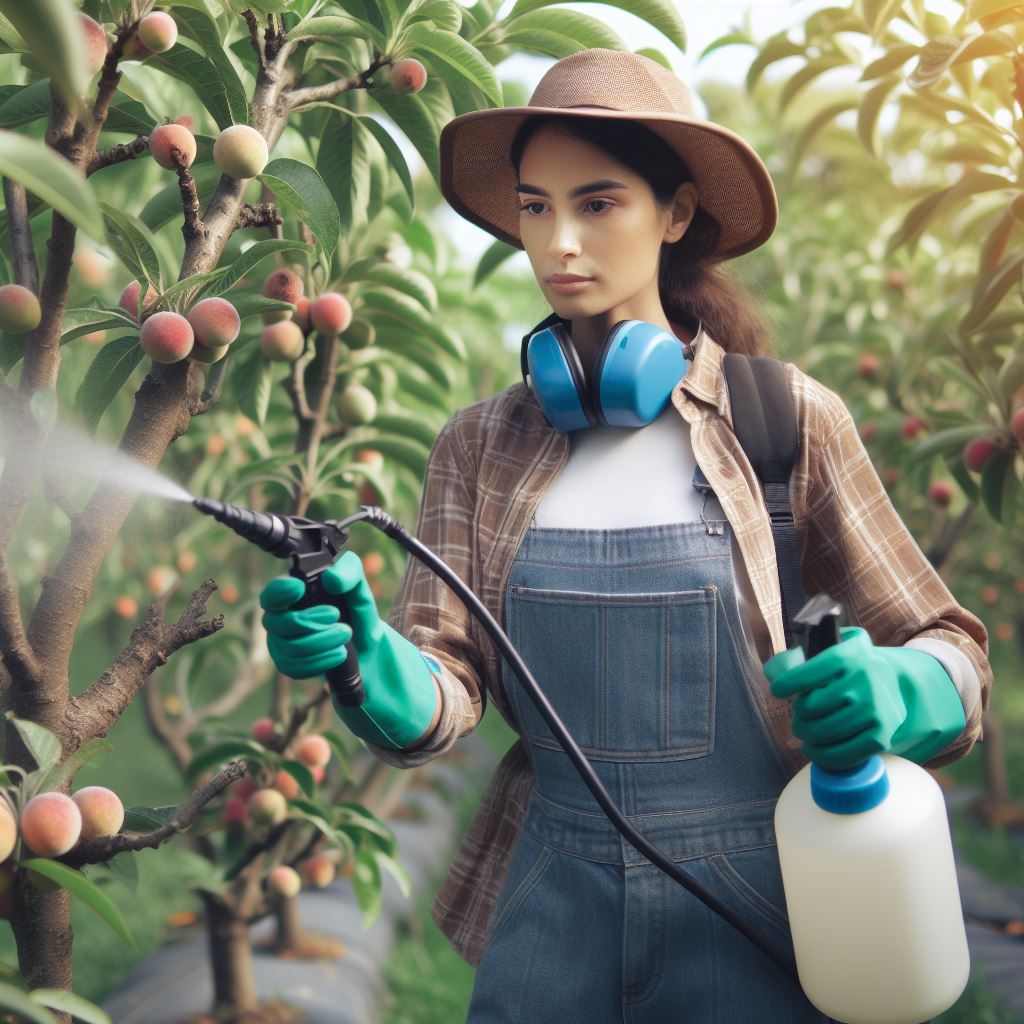Introduction
In this blog post, we will discuss IPM (Integrated Pest Management), its importance for new farmers, and what this blog post will cover.
IPM is a pest control strategy that focuses on preventing and managing pests using environmentally-friendly practices.
For new farmers, IPM is crucial as it helps minimize pesticide use, reduce costs, and protect the environment.
This blog post will cover the basics of IPM, including identifying pests, monitoring techniques, and implementing control strategies.
We will also discuss the importance of crop rotation, cultural practices, and the use of biological control agents.
Additionally, we will explore the role of chemical pesticides in IPM and provide guidelines for their safe and responsible use.
Furthermore, we will highlight the significance of regular scouting and record-keeping to keep track of pest populations and treatment effectiveness.
Throughout this section, we will provide practical tips and recommendations to help new farmers successfully implement IPM on their farms.
By utilizing IPM strategies, new farmers can improve crop health, increase yields, and promote the long-term sustainability of their farming operations.
Now, let’s dive into the world of IPM and discover how it can benefit new farmers.
Read: Herb Harvesting: Preserving Flavor & Freshness
Understanding IPM
Definition and principles of IPM
Integrated Pest Management (IPM) is an approach that aims to control pests while minimizing the use of pesticides.
It focuses on sustainable practices that prioritize prevention and the use of alternative measures.
Holistic approach to pest management
IPM goes beyond traditional pest control methods by considering the entire ecosystem. It recognizes that pests are part of a complex system and seeks to understand their interactions with the environment.
The three main components of IPM
- Prevention: The first pillar of IPM is to prevent pest problems before they occur. This involves creating a healthy and balanced environment that is less susceptible to pest attacks.
- Observation and monitoring: IPM relies heavily on regular observation and monitoring of pests and their natural enemies. This helps farmers detect any early signs of infestation and take immediate action.
- Control measures: When prevention and observation are not enough, IPM employs a range of control measures. These measures
include cultural, physical, biological, and chemical methods, used selectively and in combination to minimize environmental impact.
IPM considers long-term solutions rather than quick fixes. It aims to reduce reliance on pesticides, which can have harmful effects on the
environment, human health, and non-target species.
Transform Your Agribusiness
Unlock your farm's potential with expert advice tailored to your needs. Get actionable steps that drive real results.
Get StartedBy integrating various pest management strategies, IPM promotes sustainable agriculture.
Read: Orchard Fruit Storage: Best Practices
Discover More: Managing Pests in Organic Farming
Implementing IPM on the Farm
Conducting a farm assessment
- Identify potential pests and diseases to determine the scope of the problem.
- Understand the lifecycle and behavior of pests to effectively develop control strategies.
Setting action thresholds
- Determine when to intervene based on pest density, ensuring proactive pest management.
Prevention and cultural practices
- Manage soil health and fertility to promote plants’ natural resistance to pests.
- Implement crop rotation and diversification strategies to disrupt pest lifecycles.
- Adopt proper irrigation and drainage techniques to prevent pest breeding grounds.
Observation and monitoring
- Regularly scout the farm for signs of pests or diseases and maintain detailed records.
- Utilize traps and conduct visual inspections to identify specific pest populations.
- Utilize weather data and pest forecasting tools to predict and prevent outbreaks.
Control measures
- Implement least toxic approaches to pest control, prioritizing environmentally friendly methods.
- Leverage biological control methods such as natural predators to manage pest populations.
- Practice selective and targeted pesticide use to minimize non-target impacts.
- Employ mechanical and physical control options like trapping and barriers when suitable.
By implementing these IPM strategies, new farmers can ensure sustainable and effective pest management on their farms, ultimately leading to higher yields and a healthier environment.
Read: Harvesting Berries: Timing and Techniques

IPM Resources and Tools for New Farmers
As a new farmer interested in implementing Integrated Pest Management (IPM) practices on your farm, it is essential to have access to the necessary resources and tools that can support your journey towards sustainable and environmentally-friendly agriculture.
In this section, we will explore some of the valuable resources available to new farmers for learning and implementing IPM.
Government programs and certifications
Overview of relevant programs and incentives
Government programs and certifications play a crucial role in promoting IPM practices among farmers. These programs provide financial assistance and incentives to encourage the adoption of sustainable pest management techniques.
By participating in these programs, new farmers can access valuable resources, technical expertise, and financial support that can help them implement IPM effectively.
It is essential to explore and understand the various government programs and certifications specific to your region and farming practices.
Educational courses and workshops
Opportunities for learning IPM techniques
Education is a valuable aspect of successfully implementing IPM. Many organizations and institutions offer educational courses and workshops specifically designed to teach new farmers about IPM techniques and practices.
These classes provide hands-on training, theoretical knowledge, and practical skills necessary for effectively managing pests and diseases using IPM.
By attending these courses and workshops, new farmers can gain a deeper understanding of IPM principles and strategies, increasing their chances of successfully implementing IPM in their own farming operations.
Online resources and publications
Websites, blogs, and forums for IPM guidance
The internet offers a vast array of online resources and publications dedicated to IPM. Websites, blogs, and forums created by agricultural experts, researchers, and fellow farmers provide valuable guidance, tips, and insights into effective IPM implementation.
These online resources often contain step-by-step guides, case studies, and success stories, allowing new farmers to learn from the experiences of others.
It is crucial to explore these online platforms and leverage the wealth of knowledge available to enhance your understanding of IPM and its application in farming.
Collaboration and networking
Importance of connecting with other farmers and experts
Collaboration and networking are key to successful IPM implementation. Connecting with other farmers who practice IPM and engaging in discussions, knowledge-sharing, and problem-solving can be immensely beneficial for new farmers.
By joining local agricultural organizations, participating in farmers’ markets, attending conferences, and joining online communities, new farmers can build relationships with experienced practitioners and experts in IPM.
These connections provide access to valuable insights, advice, and support, ensuring that new farmers can navigate the challenges and complexities of IPM effectively.
In general, new farmers who are interested in adopting IPM practices can benefit from a variety of resources and tools.
Government programs, educational courses, online platforms, and collaboration opportunities play a vital role in providing the necessary support and knowledge to successfully implement IPM.
By utilizing these resources, new farmers can embark on their IPM journey with confidence and contribute to sustainable and environmentally-conscious agriculture.
Read: Maximizing Wheat Yields: Harvesting Insights
Conclusion
Recap of key points discussed in the blog post
Throughout this blog post, we have explored the basics of Integrated Pest Management (IPM).
Showcase Your Farming Business
Publish your professional farming services profile on our blog for a one-time fee of $200 and reach a dedicated audience of farmers and agribusiness owners.
Publish Your ProfileWe have learned that IPM is a sustainable approach to pest management that integrates various strategies to minimize the use of pesticides.
We discussed the importance of identifying pests accurately and understanding their life cycles, behavior, and vulnerabilities.
By doing so, farmers can implement preventive measures and choose the most effective control methods.
Furthermore, we emphasized the significance of promoting biodiversity, enhancing natural enemies, and using biological controls.
These practices not only help in reducing pest populations but also contribute to a healthier and more resilient ecosystem.
Encouragement for new farmers to adopt IPM practices
For new farmers, embracing IPM practices can be an opportunity for long-term success and sustainability.
By implementing these strategies, farmers can reduce the dependency on chemical pesticides, minimize risks to human health and the environment, and even save costs in the long run.
With the constant advancements in IPM techniques and technology, there are ample resources and support available for new farmers to learn and implement these practices.
Participating in workshops, joining local farming communities, and seeking guidance from agricultural extension services can be valuable for beginners.
Closing thoughts and invitation for further engagement or questions
We hope that this blog post has provided you with a solid foundation in understanding IPM.
If you have any further questions or would like to engage in discussion, we invite you to reach out to us or leave a comment below.
Remember, adopting IPM practices not only benefits the farm but also contributes to a healthier environment and supports sustainable agriculture.
Together, let’s build a future where farming practices are balanced, effective, and environmentally friendly.




